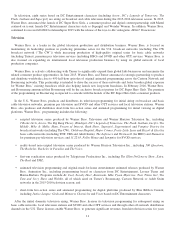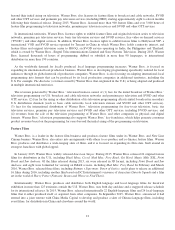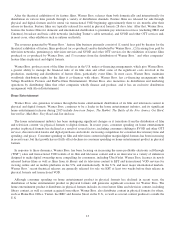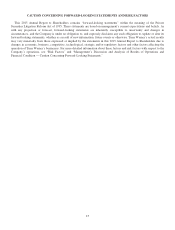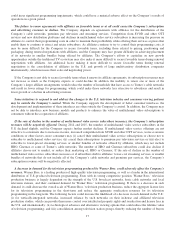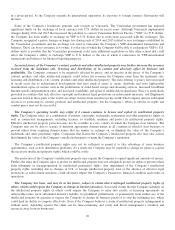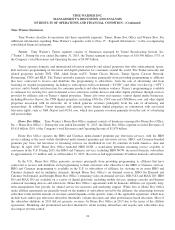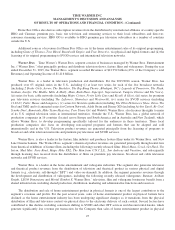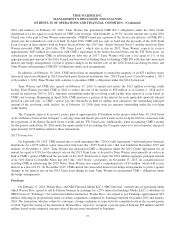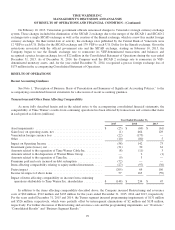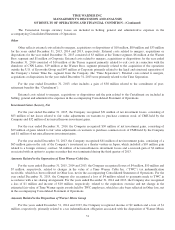Time Magazine 2015 Annual Report Download - page 35
Download and view the complete annual report
Please find page 35 of the 2015 Time Magazine annual report below. You can navigate through the pages in the report by either clicking on the pages listed below, or by using the keyword search tool below to find specific information within the annual report.The Company’s businesses are subject to labor interruption. The Company and some of its suppliers and business
partners retain the services of writers, directors, actors, athletes, technicians, trade employees and others involved in the
development and production of its television programming and feature films who are covered by collective bargaining
agreements. If negotiations to renew expiring collective bargaining agreements are not successful or become unproductive,
the affected unions could take actions such as strikes, work slowdowns or work stoppages. Such actions or the possibility of
such actions could result in delays in the production of the Company’s television programming and feature films. The
Company could also incur higher costs from such actions, new collective bargaining agreements or the renewal of collective
bargaining agreements on less favorable terms. Many of the collective bargaining agreements that cover individuals
providing services to the Company are industry-wide agreements, and the Company may lack practical control over the
negotiations and terms of these agreements. Union or labor disputes or player lock-outs relating to certain professional sports
leagues may preclude the Company from producing and telecasting scheduled games or events and could negatively impact
the Company’s promotional and marketing opportunities. Depending on their duration, such union or labor disputes or player
lock-outs could have an adverse effect on the Company’s results of operations.
Service disruptions or failures of the Company’s or its vendors’ information systems and networks as a result of
computer viruses, misappropriation of data or other bad acts, natural disasters, extreme weather, accidental releases of
information or other similar events, may disrupt the Company’s businesses, damage its reputation or have a negative
impact on its results of operations. Shutdowns or service disruptions of information systems or networks at the Company or
vendors that provide information systems, networks or other services to the Company pose increasing risks. Such disruptions
may be caused by third-party hacking of computers and systems; dissemination of computer viruses, worms and other
destructive or disruptive software; denial of service attacks and other bad acts, as well as power outages, natural disasters,
extreme weather, terrorist attacks, or other similar events. Shutdowns or disruption from such events could have an adverse
impact on the Company and its customers, including degradation or disruption of service, loss of data and damage to
equipment and data. System redundancy may be ineffective or inadequate, and the Company’s disaster recovery planning
may not be sufficient to cover everything that could happen. Significant events could result in a disruption of the Company’s
operations, reduced revenues, the loss of or damage to the integrity of data used by management to make decisions and
operate the Company’s business, customer or advertiser dissatisfaction, damage to the Company’s reputation or brands or a
loss of customers. The Company may not have adequate insurance coverage to compensate it for any losses associated with
such events.
The Company is also subject to risks caused by the misappropriation, misuse, falsification or intentional or accidental
release or loss of data maintained in the information systems and networks of the Company or its vendors, including
confidential personnel, customer or vendor data. Outside parties may attempt to penetrate the Company’s systems or those of
its vendors or fraudulently induce employees or customers of the Company or employees of its vendors to disclose sensitive
information to obtain or gain access to the Company’s data. The number and sophistication of attempted and successful
information security breaches have increased in recent years. If a material breach of the Company’s information systems or
those of its vendors occurs, the market perception of the effectiveness of the Company’s information security measures could
be harmed, the Company could lose customers and advertisers, and its reputation, brands and credibility could be damaged.
In addition, if a material breach of its information systems occurs, the Company could be required to expend significant
amounts of money and other resources to repair or replace information systems or networks or to comply with notification
requirements. The Company also could be subject to actions by regulatory authorities and claims asserted in private litigation
in the event of a breach of the information systems of the Company or its vendors.
Although the Company develops and maintains information security practices and systems designed to prevent these
events from occurring, the development and maintenance of these systems are costly and require ongoing monitoring and
updating as technologies change and tactics to overcome information security measures become more sophisticated.
Moreover, despite the Company’s efforts, the possibility of these events occurring cannot be eliminated entirely. As the
Company distributes more of its content digitally, engages in more electronic transactions with consumers, increases the
number of information technology systems used in its business operations, relies more on cloud-based services and
information systems and increases its use of third-party service providers to perform information technology services, the
related information security risks will continue to increase and the Company will need to expend additional resources to
protect its information systems, networks and data.
21


